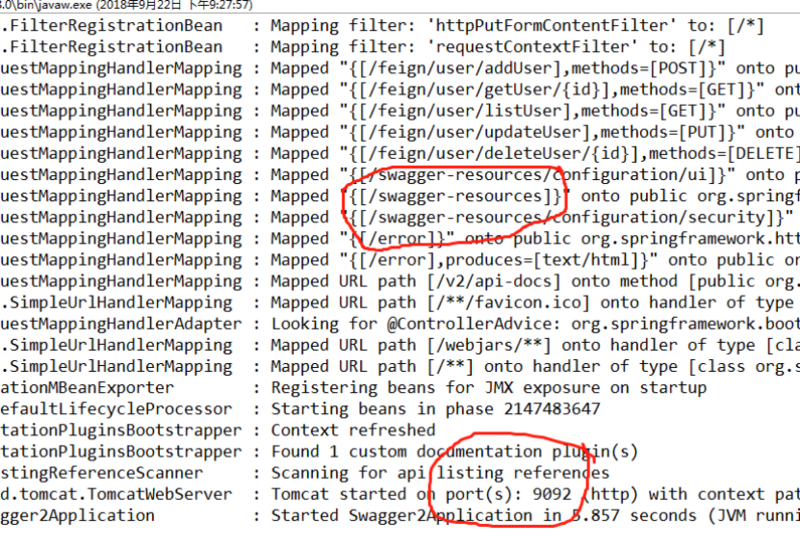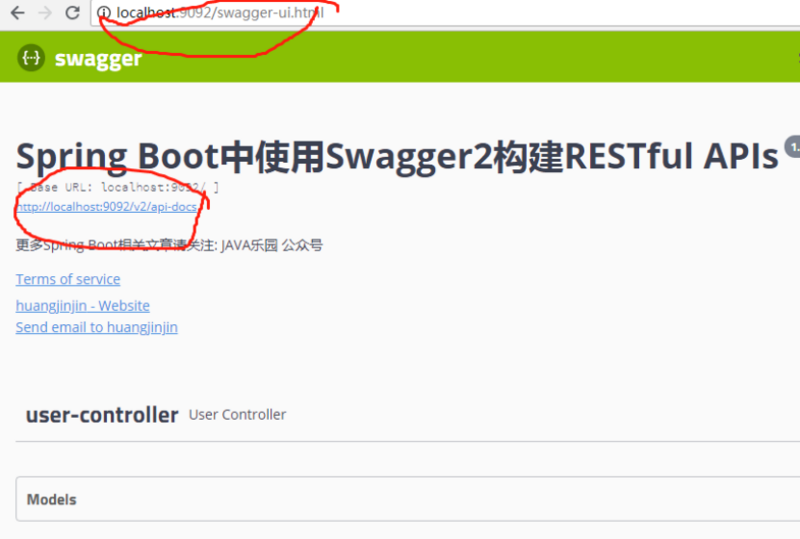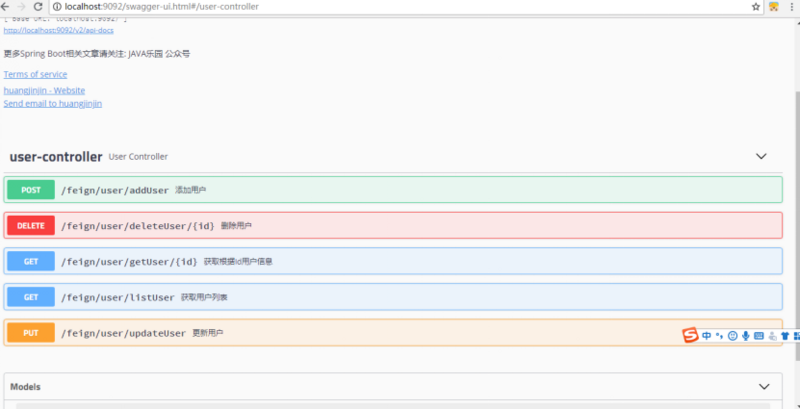16、springcloud整合Swagger2构建Restful服务的APIs
公众号: java乐园
Spring Cloud将服务注册到了Eureka上,可以从Eureka的UI界面中,看到有哪些服务已经注册到了Eureka Server上;但是如果想查看当前服务提供了哪些RESTful接口方法的话,就无法从Eureka Server获取了,而传统的方法是梳理一个接口文档来供开发人员之间来进行交流。这种情况下经常会造成文档和代码的不一致性,比如说代码改了,但是接口文档还没来得及修改等问题,而Swagger2则给我们提供了一套完美的解决方案,下面来看看Swagger2是如何来解决这个问题的。
1、新建项目sc-swagger2,对应的pom.xml文件
<project xmlns="http://maven.apache.org/POM/4.0.0" xmlns:xsi="http://www.w3.org/2001/XMLSchema-instance"
xsi:schemaLocation="http://maven.apache.org/POM/4.0.0 http://maven.apache.org/xsd/maven-4.0.0.xsd">
<modelVersion>4.0.0</modelVersion>
<groupId>spring-cloud</groupId>
<artifactId>sc-swagger2</artifactId>
<version>0.0.1-SNAPSHOT</version>
<packaging>jar</packaging>
<name>sc-swagger2</name>
<url>http://maven.apache.org</url>
<parent>
<groupId>org.springframework.boot</groupId>
<artifactId>spring-boot-starter-parent</artifactId>
<version>2.0.4.RELEASE</version>
</parent>
<dependencyManagement>
<dependencies>
<dependency>
<groupId>org.springframework.cloud</groupId>
<artifactId>spring-cloud-dependencies</artifactId>
<version>Finchley.RELEASE</version>
<type>pom</type>
<scope>import</scope>
</dependency>
</dependencies>
</dependencyManagement>
<properties>
<project.build.sourceEncoding>UTF-8</project.build.sourceEncoding>
<maven.compiler.source>1.8</maven.compiler.source>
<maven.compiler.target>1.8</maven.compiler.target>
</properties>
<dependencies>
<dependency>
<groupId>io.springfox</groupId>
<artifactId>springfox-swagger2</artifactId>
<version>2.9.2</version>
</dependency>
<dependency>
<groupId>io.springfox</groupId>
<artifactId>springfox-swagger-ui</artifactId>
<version>2.9.2</version>
</dependency>
<dependency>
<groupId>org.springframework.boot</groupId>
<artifactId>spring-boot-starter-web</artifactId>
</dependency>
</dependencies>
</project>
2、新建springboot启动类
package sc.swagger2;
import org.springframework.boot.SpringApplication;
import org.springframework.boot.autoconfigure.SpringBootApplication;
@SpringBootApplication
public class Swagger2Application {
public static void main(String[] args) {
SpringApplication.run(Swagger2Application.class, args);
}
}
3、新建Swagger2配置类
package sc.swagger2.config;
import org.springframework.context.annotation.Bean;
import org.springframework.context.annotation.Configuration;
import springfox.documentation.builders.ApiInfoBuilder;
import springfox.documentation.builders.PathSelectors;
import springfox.documentation.builders.RequestHandlerSelectors;
import springfox.documentation.service.ApiInfo;
import springfox.documentation.service.Contact;
import springfox.documentation.spi.DocumentationType;
import springfox.documentation.spring.web.plugins.Docket;
import springfox.documentation.swagger2.annotations.EnableSwagger2;
@Configuration
@EnableSwagger2
public class Swagger2Config {
@Bean
public Docket createRestApi() {
return new Docket(DocumentationType.SWAGGER_2)
.apiInfo(apiInfo())
.select()
.apis(RequestHandlerSelectors.basePackage("sc.swagger2"))
.paths(PathSelectors.any())
.build();
}
private ApiInfo apiInfo() {
return new ApiInfoBuilder()
.title("Spring Boot中使用Swagger2构建RESTful APIs")
.description("更多Spring Boot相关文章请关注: JAVA乐园 公众号")
.termsOfServiceUrl("https://edu.csdn.net/lecturer/995")
.contact(new Contact("huangjinjin", //
"https://edu.csdn.net/lecturer/995",//
"happyhuangjinjin@sina.com"))
.version("1.0")
.build();
}
}
4、新建一个模拟的Controller
package sc.swagger2.controller;
import java.util.ArrayList;
import java.util.HashMap;
import java.util.List;
import java.util.Map;
import org.springframework.stereotype.Controller;
import org.springframework.web.bind.annotation.DeleteMapping;
import org.springframework.web.bind.annotation.GetMapping;
import org.springframework.web.bind.annotation.PathVariable;
import org.springframework.web.bind.annotation.PostMapping;
import org.springframework.web.bind.annotation.PutMapping;
import org.springframework.web.bind.annotation.RequestMapping;
import org.springframework.web.bind.annotation.RequestMethod;
import org.springframework.web.bind.annotation.ResponseBody;
import io.swagger.annotations.Api;
import io.swagger.annotations.ApiImplicitParam;
import io.swagger.annotations.ApiImplicitParams;
import io.swagger.annotations.ApiOperation;
import io.swagger.annotations.ApiResponse;
import io.swagger.annotations.ApiResponses;
import sc.swagger2.model.User;
@Api(value="用户管理")
@Controller
public class UserController {
@ApiResponses({ @ApiResponse(code = 000000, message = "操作成功"),
@ApiResponse(code = 000001, message = "服务器内部异常") })
@GetMapping(value = "/feign/user/getUser/{id}")
@ResponseBody
@ApiOperation(value = "获取根据Id用户信息",response = User.class)
@ApiImplicitParam(name = "id", value = "用户ID", required = true, dataType = "Long",example="100")
public Map<String, Object> getUser(@PathVariable Long id) {
Map<String, Object> result = new HashMap<String, Object>();
result.put("code", "000000");
result.put("msg", "success");
User u = new User();
u.setId(1L);
u.setAge(23);
u.setUserName("huangjinjin");
u.setPosition("cto");
result.put("body", u);
return result;
}
@ApiResponses({ @ApiResponse(code = 000000, message = "操作成功"),
@ApiResponse(code = 000001, message = "服务器内部异常") })
@RequestMapping(value = "/feign/user/listUser", method = RequestMethod.GET)
@ResponseBody
@ApiOperation(value = "获取用户列表")
public Map<String, Object> listUser() {
Map<String, Object> result = new HashMap<String, Object>();
result.put("code", "000000");
result.put("msg", "success");
User u = new User();
u.setId(1L);
u.setAge(23);
u.setUserName("huangjinjin");
u.setPosition("cto");
List<User> list = new ArrayList<User>();
list.add(u);
result.put("body", list);
return result;
}
@ApiResponses({ @ApiResponse(code = 000000, message = "操作成功"),
@ApiResponse(code = 000001, message = "服务器内部异常") })
@PostMapping(value = "/feign/user/addUser")
@ResponseBody
@ApiOperation(value = "添加用户", notes = "根据User对象创建用户")
@ApiImplicitParams({ @ApiImplicitParam(name = "userName", value = "用户名", required = true, dataType = "String"),
@ApiImplicitParam(name = "age", value = "年龄", required = true, dataType = "String"),
@ApiImplicitParam(name = "position", value = "职位", required = true, dataType = "String"),
@ApiImplicitParam(name = "id", value = "用户ID", required = false, dataType = "Long",example="100")})
public Map<String, Object> addUser(User user) {
Map<String, Object> result = new HashMap<String, Object>();
result.put("code", "000000");
result.put("msg", "success");
result.put("body", 1);
return result;
}
@ApiResponses({ @ApiResponse(code = 000000, message = "操作成功"),
@ApiResponse(code = 000001, message = "服务器内部异常") })
@ApiOperation(value = "更新用户")
@PutMapping(value = "/feign/user/updateUser")
@ResponseBody
@ApiImplicitParams({ @ApiImplicitParam(name = "userName", value = "用户名", required = true, dataType = "String"),
@ApiImplicitParam(name = "age", value = "年龄", required = true, dataType = "String"),
@ApiImplicitParam(name = "position", value = "职位", required = true, dataType = "String"),
@ApiImplicitParam(name = "id", value = "用户ID", required = true, dataType = "Long", example="100")})
public Map<String, Object> updateUser(User user) {
Map<String, Object> result = new HashMap<String, Object>();
result.put("code", "000000");
result.put("msg", "success");
result.put("body", 1);
return result;
}
@ApiResponses({ @ApiResponse(code = 000000, message = "操作成功"),
@ApiResponse(code = 000001, message = "服务器内部异常") })
@DeleteMapping(value = "/feign/user/deleteUser/{id}")
@ResponseBody
@ApiOperation(value = "删除用户")
@ApiImplicitParam(name = "id", value = "用户ID", required = true, dataType = "Long",example="100")
public Map<String, Object> deleteUser(@PathVariable Long id) {
Map<String, Object> result = new HashMap<String, Object>();
result.put("code", "000000");
result.put("msg", "success");
result.put("body", 1);
return result;
}
}
5、新建User模型类
package sc.swagger2.model;
import java.io.Serializable;
import io.swagger.annotations.ApiModel;
import io.swagger.annotations.ApiModelProperty;
@ApiModel
public class User implements Serializable {
private static final long serialVersionUID = 4639927446947303736L;
@ApiModelProperty(name="id", dataType="Long", value="主键ID")
private Long id;
@ApiModelProperty(name="userName", dataType="String", value="姓名", required=true)
private String userName;
@ApiModelProperty(name="age", dataType="String", value="年龄", required=true)
private Integer age;
@ApiModelProperty(name="position", dataType="String", value="职位")
private String position;
public String getUserName() {
return userName;
}
public void setUserName(String userName) {
this.userName = userName;
}
public Integer getAge() {
return age;
}
public void setAge(Integer age) {
this.age = age;
}
public String getPosition() {
return position;
}
public void setPosition(String position) {
this.position = position;
}
public Long getId() {
return id;
}
public void setId(Long id) {
this.id = id;
}
}
6、启动sc-swagger2项目,并验证是否启动成功
方式一:查看日志

方式二:访问地址
http://127.0.0.1 :9092/swagger-ui.html

或者访问 http://localhost :9092/v2/api-docs

7、在界面 http://127.0.0.1 :9092/swagger-ui.html点击【user-controller】可以看到所有的接口,同时也可以在界面上进行接口调用调试

正文到此结束
- 本文标签: 配置 plugin App Feign dependencies java 文章 RESTful springboot XML zab example 服务器 map bean CTO Spring cloud REST spring https 删除 管理 Spring Boot Select ArrayList schema web cat Service 代码 springcloud Eureka http ip 调试 id Document HashMap final apache description Property SDN 一致性 list src pom UI IO HTML 服务注册 开发 update tar message API 模型 value tag build maven
- 版权声明: 本文为互联网转载文章,出处已在文章中说明(部分除外)。如果侵权,请联系本站长删除,谢谢。
- 本文海报: 生成海报一 生成海报二
热门推荐
相关文章
Loading...











![[HBLOG]公众号](https://www.liuhaihua.cn/img/qrcode_gzh.jpg)

